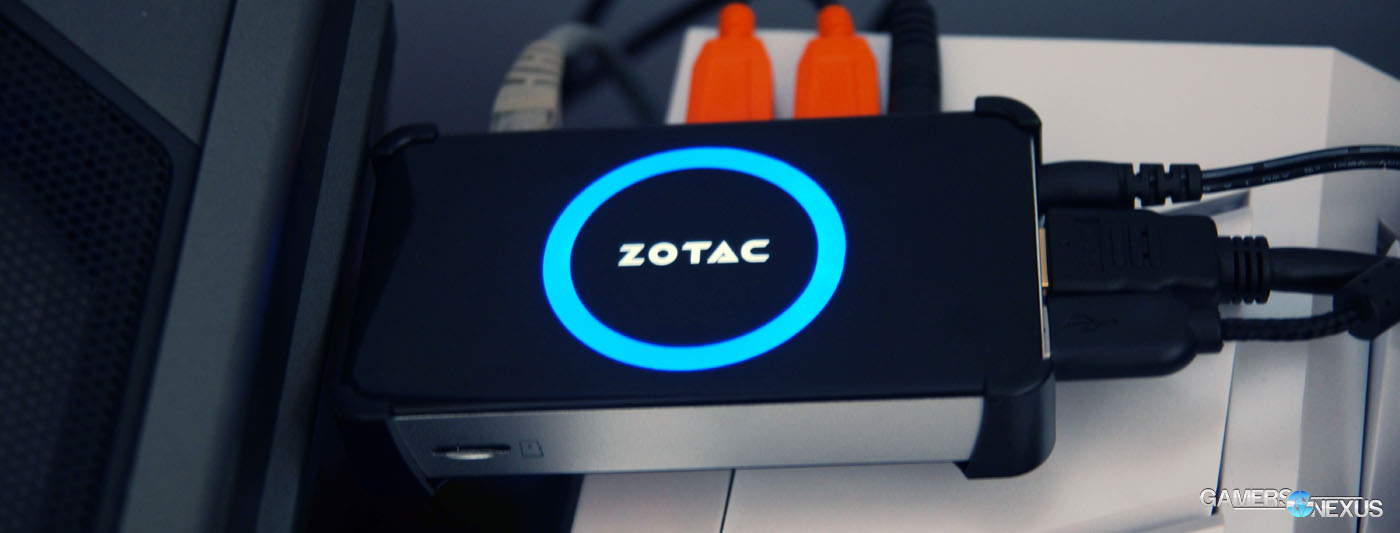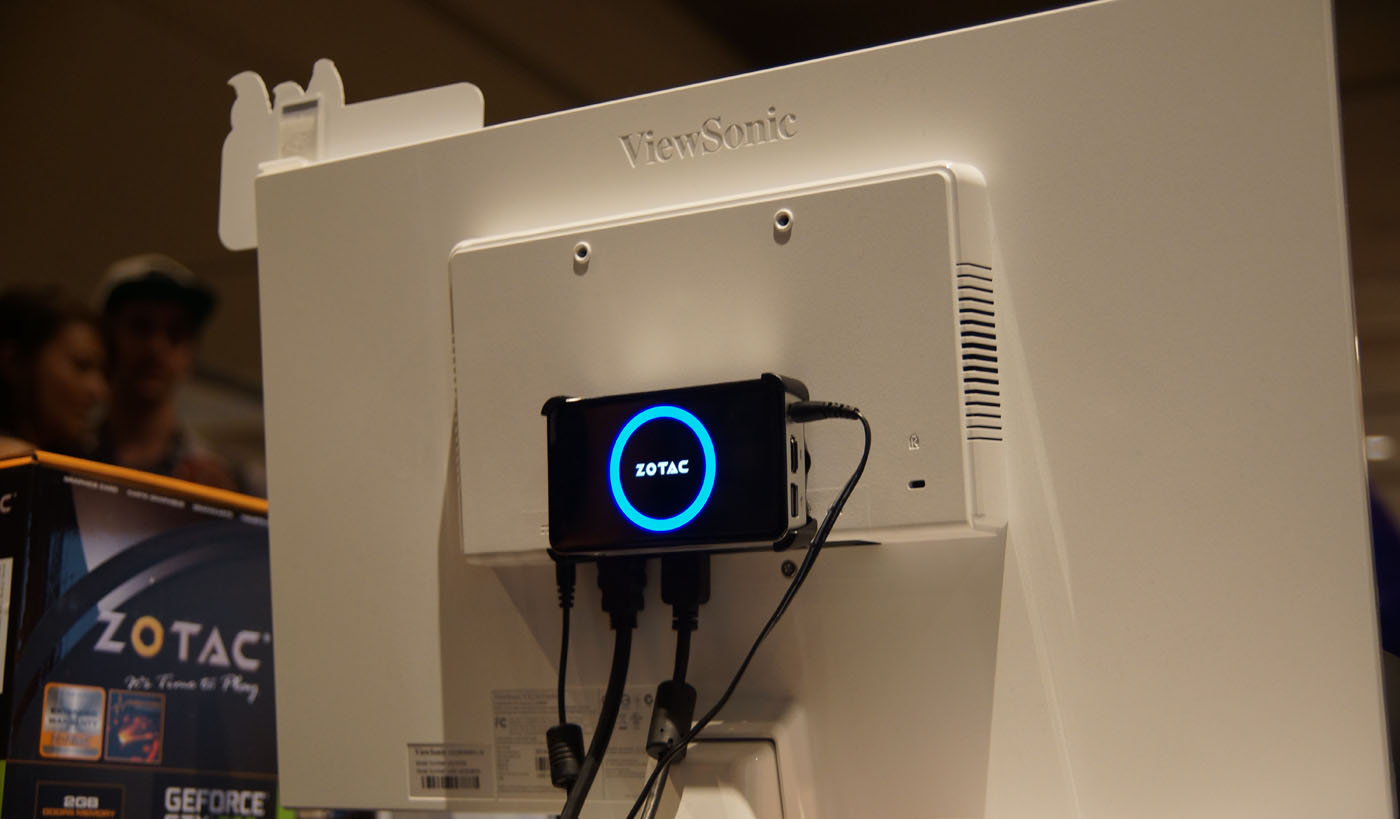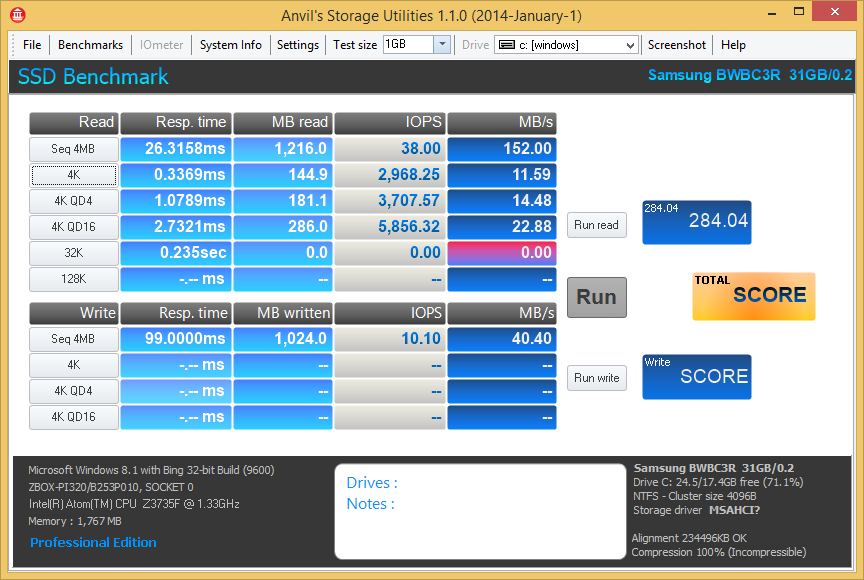We're looking at Zotac's new Pico PI320 mini-PC today which, despite its name, is not a Raspberry Pi derivative. The Pico is part of an invasion force of mini computers that has been flooding the market lately. Steam Machines are one thing – and Zotac has made those, too – but these are entirely different. Mini PCs are more targeted at low-end, TV-mounted used, generally favoring browsing and YouTube viewing over any heavy-duty tasks.
Most don't have enough storage to work as a long-term multimedia solution, demanding a more robust network-attached storage device if movie or TV file streaming is a requirement. Mini PCs also don't afford the gaming prowess required to run much more than a 2D platformer; with thanks to efforts made by Valve's Steam, AMD, and nVidia (GameStream), game streaming to a mini PC is a possibility, but even that has other throttles (network, OS / platform concerns). All these shortcomings noted, they're still viable computers – it just depends on what the user wants. For browsing, business use (documents, simple spreadsheets, day-to-day life), and down-streamed content, a mini PC has potential for deployment.
ZOTAC Pico PI320 ZBOX Hands-On Video & Game Streaming
ZOTAC Pico PI320 ZBOX Specs
| CPU | Intel Baytrail Z3740 Quad-Core 1.33GHz Turbo Boosted 0.37V vCore 2W TDP 4x24KB L1 D-cache 4x32KB L1 I-cache 2x1024KB L2 Cache |
| Memory | 2GB 1.7GB user-accessible |
| Storage | 32GB eMMC 17.4GB user-accessible after OS |
| GPU | Integrated Intel HD Graphics |
| VRAM | Shared |
| Display | HDMI |
| Card Reader | 3-in-1 micro SD/mSDHC/mSDXC |
| Network | 10/100Mbps ethernet Onboard 802.11n Wireless Bluetooth 4.0 |
| I/O | 3.5mm output HDMI audio 3xUSB2.0 |
| OS | Windows 8.1 + Bing. |
| MSRP | $200 |
The Pico has a lot of competition, but we'll talk about that more in the conclusion. Zotac's Pico is part of their long-standing “ZBOX” product lineup, including the EN760 gaming mini-PC (“Steam Machine”) that we recently reviewed. Unlike previous products, the Pico isn't really meant for much more than TV-attached use.
Intel's Bay Trail-T Atom Z3740 CPU is outfitted to the board (SOC), operating at less than 1V (vCore read-out suggests 0.37V) for a TDP of about 2W. The CPU's operating frequency boosts around depending on demand, but is capable of up to 1.33GHz. We saw the clock hovering at 0.5GHz at low-load times, ensuring that less power is consumed by the system. The Z3740 CPU is a BGA (ball-grid array / soldered), quad-core solution that relies on Turbo Boost regularly. Cache is marked at 4x24KB L1 D-cache and 4x32KB L1 I-cache, with L2 hovering at 2x1024KB. Definitely not the 20MB we saw from the 5930K – that's for sure.
As for memory and storage, the Pico uses all soldered solutions with expandable storage through a micro-SD slot. Memory is not user-serviceable and ships at 1.7GB of usable RAM, clocked to 666MHz stock at a CAS of 9-9-9-24.
So it's not very powerful and it doesn't offer a lot of active memory, but that's sort of the point.
Storage is similarly limiting: The Pico ships with 24.5GB of on-board Flash storage, of which nearly 7.1GB is allocated to the pre-installed Windows 8.1 + Bing suite. That leaves the user with 17.4GB (before updates) of accessible space. You're basically required to stream everything or insert large USB devices and micro-SD cards.
Target Audience & Use Cases
The Pico, as you'll have noticed from the above video, is equipped with a custom backplate that is VESA-compatible. Any monitor or TV that accepts VESA-mounted devices – which is most of them, these days – will be able to bear the mini-PC on the back-side for stealthy use.
In Zotac's mind – or in my interpretation thereof – the target user would mount the Pico to a display, use it for casual work (documents) and entertainment (videos / browsing), then switch to a larger system for more serious tasks. Zotac also suggested that GameStream and In-Home Streaming (via Steam) would be highly viable using their device as an interface through which the game could be output. Of course, then you're under the assumption that the buyer already has a high-end system capable of graphics rendering and export over the network.
So that's the target buyer. At $200, things get a bit questionable. That's not an unreasonable price-tag for what is effectively a phone-sized computer, but it's also halfway to a comparatively high-end HTPC setup. You're paying for size, VESA compatibility, and that's about it. If those things aren't a concern, it could potentially be wiser to invest in a better setup. It ultimately depends on the user and flexibility of budget, though; but again, you've really got to assume a buyer of the Pico already has a reasonable desktop system, considering it's going to be needed for larger media storage and game streaming.
Performance
It's tough to perform tests on this type of thing. We can't really stack it up against our test bench, since that's just a completely non-linear comparison, and we don't have access to competing mini-PCs.
In terms of performance, I did some tests that I considered real-world scenarios. One of them included the following user experience:
- Listening to locally-hosted music.
- Watching locally-hosted 1080p content (GoPro footage).
- Running a YouTube video on the right half of the screen.
- Typing a word document.
OK, so maybe it's not exactly the most realistic. But it's something I've done and should certainly push the little Atom processor somewhat hard. Depending on how the CPU was boosting at any given moment, these tasks pushed utilization between 15% and 78%, with the average resting in the 20-30% utilization range. Memory consumption – and obviously this changes based on many factors – was creeping up to 1.3GB out of the 1.7GB available.
With this workload, I was starting to notice slight stuttering in input patterns (typing) during use, though nothing seriously detrimental. A bit more resource saturation and it'd border on unusable for input, though.
Prime95 put the little Pico up to only 29C max (over ambient), which isn't too terribly hot given that idle hovered around 21C (over ambient). Real-world in-home game streaming scenarios had the Pico operating at roughly 26C.
Memory absolutely becomes a limiting factor for users who are tab-happy in their browsing habits. For the use-case outlined above, assuming no more than a few tabs (5-10), you'll be OK – but pushing the limits.
Game streaming works well. There's the obvious network limitation, but that's outside of Zotac's control and scope. I did notice, though, that ethernet connectivity on the Pico is effectively a requirement; using a wireless USB receiver resulted in terrible performance – worse than reasonable – that stemmed from what I suspect is an I/O bus limitation for the USB controller or CPU. This is further supported by the poor USB storage device performance (USB3.0 is not an option, though I was unable to saturate the USB2.0 theoretical maximum throughput).
Flash storage performance looks something like this:
Those are the reads. Writes failed in our benchmarking after 4MB sequential (Anvil likely did not know how to deal with the Pico's configuration – I wouldn't fault Zotac for this, just the test suite). As for reads, considering most transfers will be 4K or 4K QD4 (less frequently), an IOPS of ~3000 isn't all that impressive. The average SSD will push closer to the 60K-80K range. Certainly not blazing speeds. Good enough for media consumption, but somewhat painful if you're transferring data to and from attached storage devices and local Flash.
Is this thing worth it?
The Pico is $200. Let's look at competitors:
- $123 (+~$50) - Gigabyte N2807 Barebones PC. Must buy RAM, assume $50 minimum added purchase.
- $160 - ASUS Chromebox M004U.
- $240 - ASUS VivoPC-VM40B. Includes keyboard, mouse, RAM.
- $70 - Android Mini PC RK3188.
That's just the tip of it, too. There's a lot of competition in this space. It's tough to opt for the Pico over ASUS' VivoPC. The Pico is $40 cheaper which, when put another way, is a 20% increase in cost; that's potentially a substantial difference. The $40 gets twice the memory and a slightly faster CPU (with 2.5x higher TDP at 5.6W), a 500GB 5400RPM HDD, and a keyboard / mouse set. The extra storage seems more valuable than the Pico's Flash memory, though it does make the box a good deal larger (7.6 x 2.2 x 7.5” vs. the Pico's 4.5 vs 0.76 vs. 2.6”). Whether or not that's relevant is up to the buyer to decide.
The Pico streams games fine if the host system is powerful enough, it plays media without stuttering or interruption, and it handled my makeshift use-case (above) fairly well. I didn't notice any jarring or massively inhibiting issues in “every day use,” though it did start struggling when I added on the tabs. I suppose you could buy one of these and slap it to the back of your TV, then stream media (movies, games, music) from a remote system in another room – the bedroom or office, maybe – but I'm just not sure I'd want to pay $200 for that. If you wanted that, you could also buy a Chrome box / stick for less than $100, then pass through all the media externally. The only reason the Pico would be worth the $200 is if you wanted to use it as its own, self-contained, local PC; a chrome stick won't do much on its own and loses a native Windows install, but if you're just streaming media remotely, that really doesn't matter.
The Pico performs fine in testing. I was impressed with the smoothness of operation, really. I'm not the target audience, though, and I feel like the “right” user may know who they are. I'd probably buy or build a full-featured HTPC solution instead, like Zotac's own EN760. I do wish that Zotac had included a longer power cable and had spaced-out the USB ports a bit more, though. It's not possible to connect two large Predator-sized USB devices simultaneously, which is a shame, considering the limited on-device storage. The power cable is only a few feet long and may not be enough to stretch from the back of a TV to the floor.
Regardless, as for the product's value as a $200 PC, it's a tough call.
- Steve “Lelldorianx” Burke.


